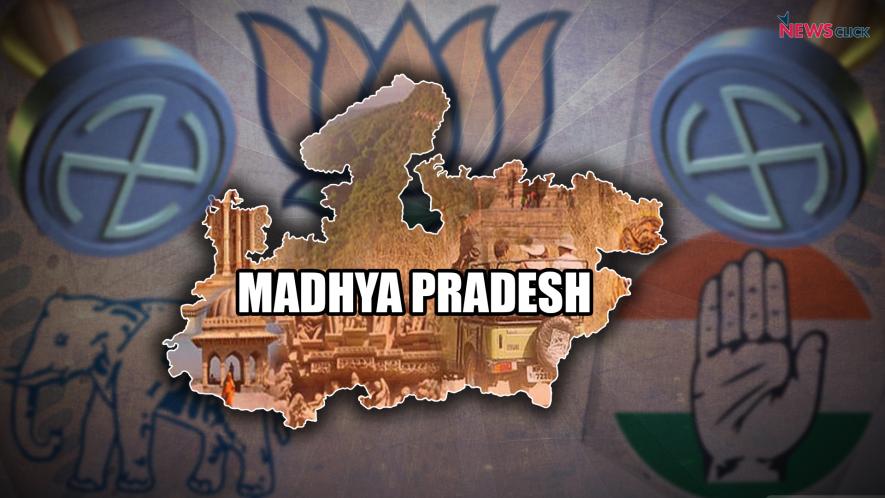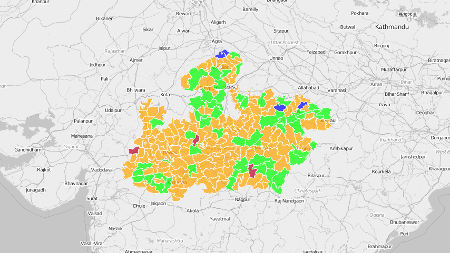MP Poll: As Campaign Ends, Voters in Mood to Usher in Change

Bhopal: As Madhya Pradesh Chief Minister Shivraj Singh Chouhan’s speech at a public meeting in Kolar in the state capital tailed off on the last day of campaign on Monday, the ruling Bharatiya Janata Party (BJP) seemed a bit edgy.
The state goes to polls on November 28 and the results will be declared on December 11, 2018.
As far as the election is concerned, Madhya Pradesh is divided into five regions other than Bhopal and its adjoining areas. These are Malwa-Nimar, Mahakoshal, Gwalior-Chambal, Bundelkhand and Vindhya Pradesh. Every region holds the key to power. And each one has a different set of problems.
Considered BJP bastions for nearly 15 years, these regions are slowly moving away from the party, according to political analysts and media reports.
Let's take a look at the political landscape of these regions.

Malwa-Nimar
Malwa-Nimar is the biggest region and the road to electoral power in the state passes through this region. No party can form a government if it is defeated in this region, spread across 15 districts and 66 Assembly seats, that is, nearly 30% of the total 230 seats.
The region stretches from Indore to the south-west bordering areas of the state adjoining Rajasthan and Gujarat. It is a farmer-dominated region and has been a BJP stronghold.
In the 2013 Assembly elections, Narendra Modi (then Gujarat Chief Minister) had addressed 11 public meetings here and the party secured a stunning victory in 56 Assembly seats out of a total of 66. Congress was left with nine and one seat went to an independent.
But, since this is a famer-dominated area, the June 6, 2017 Mandsaur farmers’ movement in which six farmers fell prey to police bullets while demanding implementation of the Swaminathan Commission recommendations, could be a game-changer and may go south for the BJP in the ensuing Assembly polls.
As NewsClick reported in the last few months, even after 17 months of the Mandsaur incident, the crops rate has been crashing to a record low. Neither are the farmers happy, nor have the family members of the deceased farmers got justice. In addition, the state government has booked thousands of farmers who took part in the June 6 farmers’ protest.
On November 24, Prime Minister Modi addressed a rally in Mandsaur but said nothing of significance for farmers.
These reasons are enough to gauge the mood of voters in the Malwa-Nimar region, who feel betrayed by the Chouhan government.
Mahakoshal
The Mahakoshal region comprises Chhindwara, Narsinghpur, Seoni,Balaghat, Katni, Dindori and Mandla, accounts for 38 Assembly constituencies, and is witnessing an intense electoral battle.
Mahakoshal is a tribal-dominated region and has been a BJP stronghold. In 2013, the BJP won 24 seats, the Congress 13 and one seat went to an independent.
But, this time, the Congress may change the equation in the region because of senior Congress leader and state Congress chief Kamal Nath's influence. Nath has been an MP from Chhindwara for last eight times and is a potential Chief Ministerial candidate if Congress is voted to power. This factor will definitely influence the voters’mind.
It remains to be seen if the region, which is facing issues like farm distress, upper caste resentment over the SC/ST Atrocities Act, migration and anti-incumbency, continues to back BJP this time around too.
Senior journalist and political commentator NK Singh, who recently visited the region, doesn’t see this happening. He said, “On multiple seats, there are triangular fight between BJP, Congress and Bahujan Samaj Party. But overall, Congress has an edge there because the state government has failed to create employment, infrastructure in the region in the last 15 years and its stand on SC/ST Atrocities Act will hit hard.”
Also, there is a huge anti-incumbency against the local BJP leaders,which may go against the party, Singh added.
Bundelkhand region
Bundelkhand comprises Sagar, Damoh, Panna, Chhatarpur and Tikamgarh and accounts for 26 Assembly seats. The farming-dominated region has a mixed population.
In 2013, BJP had won 20 out of 26 Assembly seats in Bundelkhand region, leaving Congress with six. But, this time the saffron party is witnessing strong anti-incumbency, resentment among upper caste voters over the SC/ST Act issue, loss in farming, migration owing to unemployment, drought for the fourth time in a row and corruption in drought relief packages of Rs 3,760 crore allotted by the Union government. These issues may dent the BJP’s prospects of repeating its 2013 success.
According to a Hindustan Times’ report based, the political mood among Bundelkhand voters reflects a unanimous desire for badlaav or change.
Vindhya Pradesh
Vindhya is home to seven districts and sends 30 representatives to the Assembly. In 2013, BJP won 16 seats, Congress 12 and others the remaining two.
A Rajput community-dominated region, it may witness a triangular contest in the ensuing Assembly election.
Despite the influence of Leader of the Opposition Ajay Singh, who belongs to Sidhi constituency, BJP managed to win 16 seats in the previous elections. But resentment among upper caste voters over the SC/ST Act, anti-incumbency against the local leader, unemployment and lack of development are key issues in the region that may create trouble for the ruling BJP.
Gwalior-Chambal
Gwalior-Chambal fills 34 seats in the state Assembly and is pocket of influence of Congress MP Jyotiraditya Scindia. The BSP has the strongest presence here, with maximum polarisation of votes along caste lines in Gwalior-Chambal and the Vindhya region. With no Congress-BSP alliance, the non-BJP votes are likely to split. But there is anger among Dalits against the BJP after seven persons were killed in caste violence during the Bharat Bandh called by Dalit outfits on April 2.
A Hindustan Times report says that the April 2 incident has widened caste fault lines and has emerged one of the main political issues in the region ahead of the Assembly election because SC/STs make up about 23% of the electorate in the region, according to government records.
NewsClick has reported in detail about the huge anger among voters not only in the region but also in the state over the April 2 violence. During the Bharat Bandh, seven people, all Dalits, were killed in the protest, but the state government has not taken any action against the killers, and has instead booked Dalit youths.
A look at the region-wise voter disenchantment, it seems that there is a desire for change among voters, which can be traced to local fatigue after a decade and a half of BJP being in power in MP.
Disillusionment and anger against the local MLAs, a backlash after ticket distribution; anger among various groups -- farmers, small traders, the young -- over policy failures, Dalit alienation and the state government’s inability to convert its welfare schemes into political support; and the limited, almost non-existent, impact of Narendra Modi’s persona in these elections are issues that are impacting voter mood and may well usher in change in Madhya Pradesh as D-day nears on November 28.
Get the latest reports & analysis with people's perspective on Protests, movements & deep analytical videos, discussions of the current affairs in your Telegram app. Subscribe to NewsClick's Telegram channel & get Real-Time updates on stories, as they get published on our website.
























